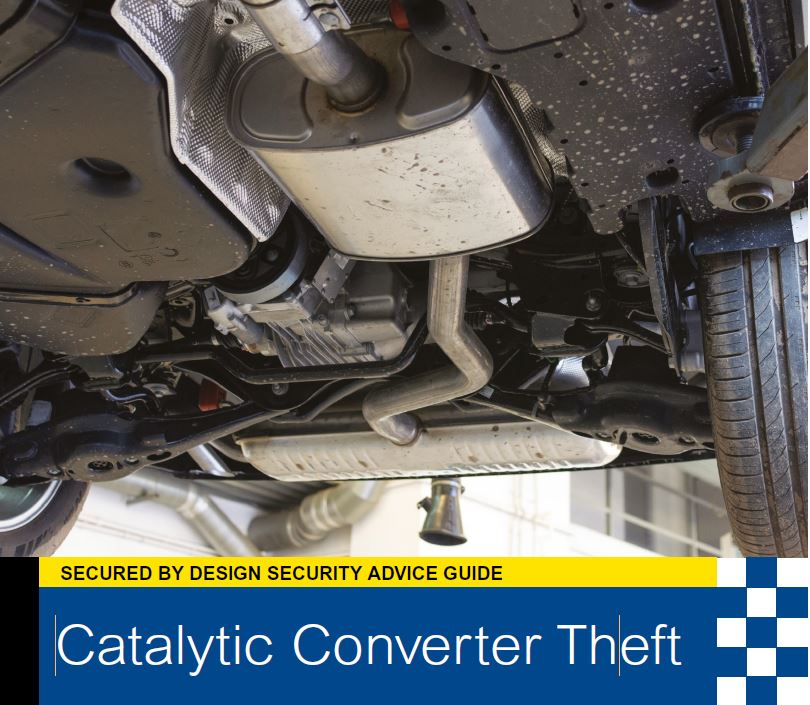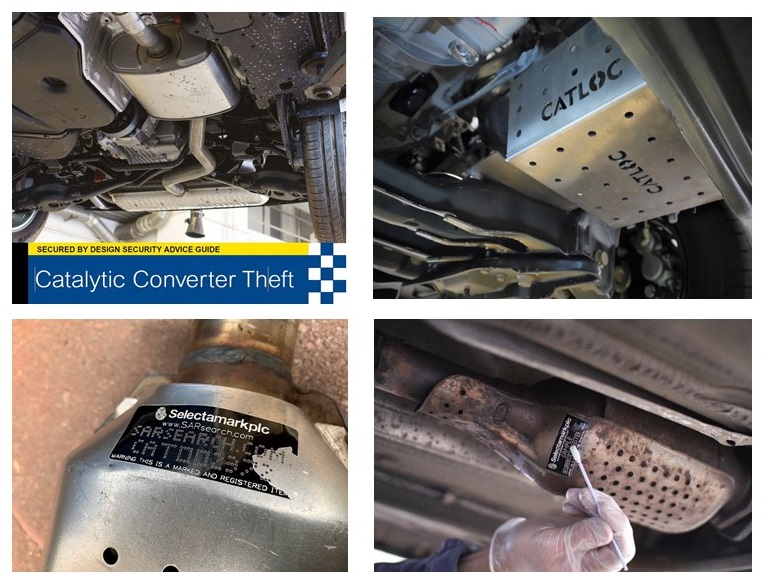Catalytic Converter theft – how to reduce the chances of becoming a victim
Catalytic converter theft has unfortunately been in the news again recently, with vehicles being targeted for the precious metals such as rhodium, platinum and palladium that are used in catalytic converters.
Police forces across the UK are committed to tackling catalytic converter theft, disrupting the criminal gangs that are largely responsible for these offences and bringing perpetrators to justice – earlier this week officers from Kent Police arrested two men in Dartford believed to have stolen catalytic converters in Maidstone, recovering a number of catalytic converters, a jack, cutting equipment and gloves.
The cost of replacing a catalytic converter is expensive, not to mention the inconvenience of having your vehicle out of action whilst it is replaced. However, there are steps that you can take to protect your vehicle and make it less likely that your vehicle will be targeted by thieves.
So what exactly is a catalytic converter?
Catalytic converters are devices fitted to vehicle exhausts to reduce the amount of dangerous gases emitted. They are often targeted by thieves as they contain valuable metals and can be removed in less than a minute.

What vehicles are targeted by these thieves?
Cars that are most often targeted are hybrid vehicles, as these vehicles have two power sources, so the catalytic converter is used less frequently. The metals are less likely to corrode meaning the converters are in a better condition, so they are worth more and therefore more attractive to thieves.
On diesel cars, the diesel oxidation catalyst is often integrated with the Diesel Particulate Filter (DPF) and there is evidence that these are being stolen for their scrap value too.
Hybrid cars, vans and Sports Utility Vehicles (‘SUV’s’) are particularly at risk, as the ride height makes access to the exhaust system beneath them easier.
However, don’t be lulled into a false sense of security if you don’t have one of these vehicles - thieves often jack up a car with a small trolley jack and quickly remove catalytic converters from any vehicle, even in the daytime.
The offenders also often use high-vis clothing or disguise themselves as motor professionals during the daytime making it easier for catalytic converter theft as people assume they are working on a vehicle.
Where do these crimes take place?
Catalytic converter theft most frequently occurs in car parks, but can actually happen anywhere. Thieves then sell these converters via scrapyards, online, or ship them out of the country.
How can I protect my vehicle’s catalytic converter?
To keep your vehicle safe from catalytic converter theft, ask your manufacturer or dealer if they can give you any advice on clamps or guards to protect the catalytic converters under the vehicle. For safety reasons, any products will need to be approved by the vehicle manufacturer for use on your vehicle model and you should also make your insurance company aware of any vehicle modifications.
Once an unmarked converter has been removed from a vehicle it is very difficult for police to match it back to the individual vehicle and crime, as there are not any distinguishing marks on catalytic converters. Thousands have been recovered by the police in operations around the country – having a distinguishing mark using an approved marking system could possibly lead to a conviction for this type of crime.
Security marking of catalytic converters with a unique code is possible but it needs to be done with an approved Secured by Design product that is heat resistant as exhausts get very hot. The marking system is best applied by a garage when the vehicle is being serviced. These kits also include window warning stickers to advise would-be-thieves that the catalytic converter has been security marked.

So what else can I do to make my vehicle less likely to be targeted?
When parking at home, consider using your garage rather than leaving your vehicle on the drive or in the street. For more advice about garage security visit https://www.securedbydesign.com/guidance/crime-prevention-advice/vehicle-crime/car-security/garage-security
Most modern vehicles which have a catalytic converter fitted also have a factory fitted alarm system, which can detect and activate if a vehicle is lifted or tilted with a trolley jack. Make sure you have locked and set the alarm when leaving the vehicle. Commercial vans may not have an alarm fitted as standard, so speak to your dealership about the possibility of installing a Thatcham / Secured by Design approved alarm system.
At the front of your property, install an LED security lighting operated by a daylight sensor. Secured by Design encourages, wherever possible, the use of the most environmentally friendly light sources. Try to position lighting so that it is not a nuisance to neighbours or a distraction to road users.
Technology which allows you to monitor your home and property has changed considerably in recent years. The Internet of Things [IOT] now includes Wi-Fi doorbells and camera systems. These can be linked to your phone and tablet to alert you to any activation and view your property in real time.
The installation of closed-circuit television (CCTV) which can be linked to your television or video to view your drive is an alternative. However, in monitoring your driveway, it is very important to remember that you must comply with the requirements of GDPR. For more advice about CCTV, visit https://www.securedbydesign.com/guidance/crime-prevention-advice/vehicle-crime/cctv-security-advice
How about when I am parking away from home?
When away from home, consider using a Park Mark approved car park. It is a national standard for UK car parks that have measures in place to ensure the safety of people and vehicles. One of the conditions of the award is that the facility must have lower levels of crime than the surrounding streets and thereby it stands out as the best place to park vehicles.
The distinctive Park Mark signage helps you find these car parks where you can confidently leave your vehicle knowing the environment is safer. The Park Mark website https://www.parkmark.co.uk/ has search facility by which you can identify a Park Mark car park to ensure you are able to park in a safer environment when undertaking your next journey.

There are nearly 5000 Park Mark award holding car parks throughout the UK, including car parks in shopping centres, leisure centres, hospitals, hotels, train stations and airports. This is around a quarter of all car parks around the country, with the smallest having 10 spaces and the largest having 13,000. You can find them in cities, towns, villages and tourist attractions.
For further advice on catalytic converter theft, or for products that have achieved Secured by Design’s Police Preferred Specification, visit https://www.securedbydesign.com/guidance/crime-prevention-advice/vehicle-crime/catalytic-converter-theft
Anyone who has any information about catalytic converter thefts should contact your local police force. Always report the crime if you are a victim and remember if a crime is in progress always dial 999.